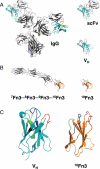Adnectins: engineered target-binding protein therapeutics
- PMID: 21068165
- PMCID: PMC3003446
- DOI: 10.1093/protein/gzq097
Adnectins: engineered target-binding protein therapeutics
Abstract
Adnectins™ are a new family of therapeutic proteins based on the 10th fibronectin type III domain, and designed to bind with high affinity and specificity to therapeutically relevant targets. Adnectins share with antibody variable domains a beta-sheet sandwich fold with diversified loops, but differ from antibodies in primary sequence and have a simpler, single-domain structure without disulfide bonds. As a consequence, Adnectins bind targets with affinity and specificity as high as those of antibodies, but are easier to manipulate genetically and compatible with bacterial expression systems. Adnectins that bind macromolecular targets with nanomolar and picomolar affinity have been selected using in vitro evolution methods, including mRNA display, phage display and yeast display. CT-322, a PEGylated, anti-angiogenic Adnectin that binds vascular endothelial growth factor (VEGF) receptor 2 and blocks its interaction with VEGF A, C and D, is being evaluated in Phase II clinical trials for efficacy in several oncology indications.
Figures

Similar articles
-
A fibronectin scaffold approach to bispecific inhibitors of epidermal growth factor receptor and insulin-like growth factor-I receptor.MAbs. 2011 Jan-Feb;3(1):38-48. doi: 10.4161/mabs.3.1.14168. Epub 2011 Jan 1. MAbs. 2011. PMID: 21099371 Free PMC article.
-
Target-binding proteins based on the 10th human fibronectin type III domain (¹⁰Fn3).Methods Enzymol. 2012;503:135-56. doi: 10.1016/B978-0-12-396962-0.00006-9. Methods Enzymol. 2012. PMID: 22230568
-
Anti-tumor effect of CT-322 as an adnectin inhibitor of vascular endothelial growth factor receptor-2.MAbs. 2010 Mar-Apr;2(2):199-208. doi: 10.4161/mabs.2.2.11304. MAbs. 2010. PMID: 20190562 Free PMC article.
-
FN3: a new protein scaffold reaches the clinic.Drug Discov Today. 2009 Oct;14(19-20):949-55. doi: 10.1016/j.drudis.2009.06.007. Epub 2009 Jul 2. Drug Discov Today. 2009. PMID: 19576999 Review.
-
In vitro-engineered non-antibody protein therapeutics.Protein Cell. 2018 Jan;9(1):3-14. doi: 10.1007/s13238-017-0386-6. Epub 2017 Mar 7. Protein Cell. 2018. PMID: 28271446 Free PMC article. Review.
Cited by
-
Development of a multipurpose scaffold for the display of peptide loops.Protein Eng Des Sel. 2017 Jun 1;30(6):419-430. doi: 10.1093/protein/gzx017. Protein Eng Des Sel. 2017. PMID: 28444399 Free PMC article.
-
Epitope-guided engineering of monobody binders for in vivo inhibition of Erk-2 signaling.ACS Chem Biol. 2013 Mar 15;8(3):608-16. doi: 10.1021/cb300579e. Epub 2012 Dec 18. ACS Chem Biol. 2013. PMID: 23227961 Free PMC article.
-
Imaging using radiolabelled targeted proteins: radioimmunodetection and beyond.EJNMMI Radiopharm Chem. 2020 Jun 23;5(1):16. doi: 10.1186/s41181-020-00094-w. EJNMMI Radiopharm Chem. 2020. PMID: 32577943 Free PMC article. Review.
-
Applications of Yeast Surface Display for Protein Engineering.Methods Mol Biol. 2015;1319:155-75. doi: 10.1007/978-1-4939-2748-7_8. Methods Mol Biol. 2015. PMID: 26060074 Free PMC article. Review.
-
Small-molecule modulators of the constitutive androstane receptor.Expert Opin Drug Metab Toxicol. 2015 Jul;11(7):1099-114. doi: 10.1517/17425255.2015.1043887. Epub 2015 May 15. Expert Opin Drug Metab Toxicol. 2015. PMID: 25979168 Free PMC article. Review.
References
-
- Batori V., Koide A., Koide S. Protein Eng. 2002;15:1015–1020. - PubMed
-
- Beck A., Wurch T., Bailly C., Corvaia N. Nat. Rev. Immunol. 2010;10:345–352. - PubMed
-
- Binz H.K., Pluckthun A. Curr. Opin. Biotechnol. 2005;16:459–469. - PubMed
-
- Bloom L., Calabro V. Drug Discov. Today. 2009;14:949–955. - PubMed
-
- Bradbury A.R., Marks J.D. J. Immunol. Methods. 2004;290:29–49. - PubMed
Publication types
MeSH terms
Substances
LinkOut - more resources
Full Text Sources
Other Literature Sources
Research Materials

